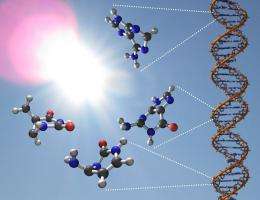How do DNA components resist to damaging UV exposure?

The genetic material of DNA contains shielding mechanisms to protect itself from the exposure to the UV light emitted by the sun. This is of crucial importance, since without photostability – i.e. without "programmed" defense mechanisms against UV irradiation – a rapid degradation of DNA and RNA would be the consequence. As part of a project funded by the Austrian Science Fund (FWF) a group of researchers led by Hans Lischka, Quantum Chemist of the University of Vienna, Austria, could, for the first time, comprehensively unravel these ultra-fast processes of the photostability of the nucleobases. In this context a publication appeared in the current issue of the prestigious journal Proceedings of the National Academy of Sciences (PNAS).
The effect of sunlight on our skin not only leads to desired tanning which enhances pleasant holiday feelings, but it also initiates processes that can lead to serious health damage. A research team led by Hans Lischka, Professor at the Institute for Theoretical Chemistry, University of Vienna, Austria, investigated the shielding mechanisms that nature has provided to protect itself against such harmful effects. The strategy here is simple, yet highly complex: As soon as the UV light excites the electrons into a higher energy level, ultra-fast decay brings them back to its original state. In this way electronic energy is converted into heat. This process occurs in an incredibly short time dimension, in up to a quadrillionth of a second.
Computer simulations on the properties of light-active DNA components
In the group of Hans Lischka (Institute for Theoretical Chemistry, University of Vienna), together with Mario Barbatti (now Max-Planck-Institut für Kohlenforschung, Mülheim/ Ruhr, Germany) and in collaboration with colleagues of the Czech Academy of Sciences in Prague, Czech Republic, a vivid dynamic picture of the photostability of the nucleobases was given using innovative computer simulation techniques. It could be shown how the DNA components - the nucleotides that are responsible in DNA and RNA for the formation of base pairs - protect themselves against decomposition under UV irradiation.
New Quantum Chemical approaches for photophysical studies
The principal innovation of this work consists in the detailed calculation of the coupling of the electronic dynamics with that of the atomic nuclei. This goal was achieved with the help of worldwide unique quantum chemical methods developed at the Institute for Theoretical Chemistry, University of Vienna. The calculated states of motion of the nucleobases show a quite remarkable dynamic behavior in time that spans several orders of magnitude - from the pico/trillionth to the femto/quadrillionth-second range.
The newly developed methods are suitable not only for elucidation of the above-described dynamics in DNA nucleobases, but they are also applicable to studies of photo-physical processes in DNA itself and in the area of photovoltaics which is of high technological interest. The new methods allow a better understanding of the fundamental processes of transport of electronic excitation energy and of charge separation for production of electricity.
More information:
Proceedings of the National Academy of Sciences of the United States of America (PNAS): Relaxation mechanisms of UV-photoexcited DNA and RNA nucleobases. Mario Barbatti, Adélia J. A. Aquino, Jaroslaw J. Szymczak, Dana Nachtigallová, Pavel Hobza, and Hans Lischka.
www.pnas.org/cgi/doi/10.1073/pnas.1014982107
Provided by University of Vienna















